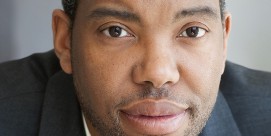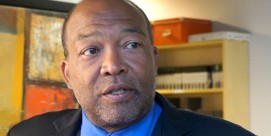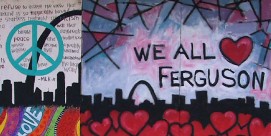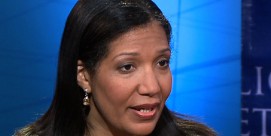In This Episode << SLIDE LEFT TO SEE ADDITIONAL SEGMENTS
Interview with Michael Emerson
Read more of Lucky Severson’s interview about interracial churches with Michael Emerson, Allyn R. and Gladys M. Cline Professor of Sociology and director of the Center on Race, Religion, and Urban Life at Rice University and the author of PEOPLE OF THE DREAM: MULTIRACIAL CONGREGATIONS IN THE UNITED STATES (Princeton University Press, 2006):
Q: Fewer than ten percent of churches in America are integrated.
A: Yeah, that comes from our research here, actually.
Q: The number is that low?
A: Yeah, seven percent. That’s what it is.
Q: Were you surprised at that?
A: Yes. Well, yes and no. But yeah, that’s pretty low.
Q: Why? What are the reasons for its being so low?
A: There are three things, and it depends on the group that we’re talking about, but there’s history, there’s culture, and then there’s social networks. So, you know, historically black and white, they worship together until about the end of slavery, and people started moving out into separate churches. But it was because of discrimination and racism and such that blacks began to establish their own denominations and their own churches.
Q: They worshipped together before the Civil War?
A: Absolutely. In part because they had no choice, right? If you were a slave, you did what the master said. And they said to worship: “You’re going to worship with us.” Now they had to sit in separate places and sometimes they’d even have to sit outside and look through the windows. But they did worship together. So we didn’t get the denominations and the separate congregations really till about into Civil War time. What’s happened then, of course, is now that we’ve had well over 100 years of this history to establish separate cultures, different ways of worshipping, and different ways of understanding theology so that when people try to come together makes it very difficult. And then, of course, social networks, you know, how do we find a place to worship? We go where our family goes. We go where our friends are, and because our social networks are so segregated by race, we end up with what we have. We also find that, you know, if you’re immigrants, you’re not part of that history. So it’s a little bit different experience. So it may be a language that separates you — again, social networks. But second-generation Asian and Hispanics, second, and third and fourth and so on, they are much more likely to be in integrated churches than are blacks or whites.
Q: Are churches a reflection of our society? We live in different neighborhoods. We work in different jobs.
A: They are. But what we found in the study is that churches are ten times less diverse than the neighborhoods they sit in. So there’s something more going on than just reflecting the neighborhood, yeah.
Q: What is going on? Is it cultural — that it is difficult to accept an outsider? Is a black church accepting whites, or the other way around?
A: I’ve been in both settings and observed, and I think when non-blacks visit a black church they will feel, they always talk about feeling so welcomed and warmly greeted but being surprised or shocked or whatever by the length of the service, by the different worship style. If we go into white congregations, non-whites will sometimes say it felt like worship never started. It was sort of dead and didn’t feel that warmly received. But so — and there are different realities either way, and it makes it difficult for all groups to try and cross boundaries.
Q: Generally white services are more calm and by the book and a lot more emotion in black services. Is that difficult for whites when they go into a black church?
A: Right, right. Preaching styles and people being slain in the spirit and things like that. Now it doesn’t happen in all black churches, and it happens sometimes in white churches, right? But on average they’re quite a bit different.
Q: The congregation saying “Amen”?
A: Call-and-response style, yes, exactly. So whenever different groups get together then there has to be this long period of negotiation. How will we worship? What’s acceptable? What’s not? If I want to say “Amen” can I? It’s one of the things we find in these congregations is that they are much more likely to be sort of up-beat worship styles, more likely that people in these congregations say “Amen,” maybe get up and dance some, tend to be a little bit more lively than a typical white service would be, but not as lively as a typical black service would be.
Q: What is most likely, a black church that’s integrated with whites or vice versa?
A: We rarely see that. Almost never.
Q: Why is that?
A: Because I think whites are used to being in power, so when whites think we ought to have integrated churches they think, “People ought to come to our church. What can we do to get them to come?” I meet almost no one that goes to an African-American church or thinks, “I’m going to do that.” Now there are whites in African-American churches. They’re interracially married. They’re highly committed. Maybe there’s a professor or two, or a student. Once in a while you get people that maybe because of economic reasons, or have a social network, they get attracted. But it’s a very tiny percent so that when we look at, you know, who are pastors and who are the head clergy of these congregations, they’re overwhelmingly white, just a few African Americans, and those folks are usually called to what were formerly white congregations, or they started interracial church from the get-go.
Q: If the pastor is black, are whites going to be less likely to go to that church because the pastor is black and in charge?
A: Yup. It’s the sad fact of how race still works in our country. We find that over and over again.
Q: But a white church doesn’t feel very welcoming to African Americans, right?
A: That’s right, that’s right. So you can see what is the difficulty. I mean, how do you make these things happen? We’ve done a lot of studies to see when they do happen, why, and I mean there’s a variety of reasons. But one, it starts with a commitment where they decide this is going to be who we are. Maybe it’s out of their faith, a new way of looking at their faith, that we must be integrated across race. So they actually put it into their mission statement, and they start changing things as a result. They may change how worship works. They may actively recruit folks and try and get them to come and help them to feel comfortable and get them involved in leadership, and there’s a variety of ways.
Q: Are they glad they did it? Does the church end up being richer for it?
A: I never meet a church that wishes they didn’t do it. I never meet a leader that wishes they didn’t do it. They will all say, to the person, it’s hard. It’s difficult. It comes with complexities and confusion as you’re trying to go across cultures, and you don’t understand, you didn’t mean to offend somebody but you’ve offended somebody. But they will all say it just does something. They could never go back to being a uniracial congregation again. It brings excitement. It brings life. It allows them to be able to know people they would never know, to meet people that are outside the congregation they would have never connected with, you know, through the networks that they developed in the congregation.
Q: Would our society be a better society if we had more integrated churches?
A: I certainly think so, and I argue so, and I give talks on that. Are there risks by putting people together? Absolutely. Is there value in the black church? Absolutely. Is there value in having immigrant churches? Absolutely. But if we don’t have congregations gathering with people of different races, what we’re doing is we are redefining racial division, a racial inequality. I spent a lot of time developing in books why worshipping separately actually impacts inequality, economic, social, on and on. So I really do believe there are huge advantages to being together even though it’s difficult, even though we have a lot to learn.
Q: Is this integration happening more in one part of the country than in another part?
A: It happens a little bit more in the West, where there’s more fluid — where everybody’s originally from somewhere else. So they have a little bit more permission to do it. It happens the least, at the individual level at least, in the South, because the South has very strong, you know, set up black churches and white churches and a long history of that, and so it’s a bigger social cost. One of the things we find when we talk to people that attend these congregations, they all have social cost to it. People want to know why they’re doing that. Sometimes they’re questions about selling out on their race or “Are we not good enough that you have to go to this kind of congregation and not ours?” So there are costs to it, and I think they’re a little bit higher in the South because of its history.
Q: I guess a pastor really sometimes has to walk a tightrope as well as really be an amazing politician, too.
A: Absolutely. Every pastor I talk to says, and particularly if they’re African American they’ll say, “I’m not black enough for African Americans. I’m not white enough for the whites. I’m not Hispanic enough.” There’s always that sense of because we’re so racially defined, if you’re trying to cross the boundaries you don’t fit into any particular space. We just say there are five, you know, racial groups in the US. I say that these folks are what we call a sixth American. There’s something different. They are somebody who — they don’t exist in any particular racial category, so they all feel it and they kind of congregate to each other. So you find a lot of these sixth Americans congregate in these interracial congregations. They hang out together at work, at school, wherever.
Q: There is an impression that in many ways church has meant more to the black community over the years than any other particular section of America.
A: Absolutely. It may be changing, but still it’s the one place, that total control of an institution, that African Americans have. So sometimes, you know, you’ll hear the statement of African Americans saying, “I have to work with whites. I may have to shop with them. But on Sunday I don’t want to have to worship with them. I want to be able to just be myself and let my hair down.” It’s also, of course, as we know, the seat of political organization and the affirming of your blackness and so on.
Q: And hearing liberation theology. Is that fairly common, as in Jeremiah Wright’s church?
A: Yeah, there are variations of it. He says that very strongly, and you’ll find congregations that do that and others that would not say it as strongly. But it is a very common strain. Yeah, absolutely.
Q: Do African Americans worry that if whites come to my church, they’re going to take over?
A: Oh yeah, absolutely. That’s a big fear, right, and when I talk with black pastors, the same thing: If we try to have this move towards interracial congregations, whites will just dominate then. There are so many more of them, and they’re used to being in the position of power. So they’ll just take over, and we’ll lose the one thing we do have.
Q: I imagine there are phrases in the Bible they have to be very careful how they use.
A: Absolutely. There’s a lot of terminology, like “washes whiter than snow,” and these things which when they’re said in a uniracial congregation, they just go fine. But when they’re said in a mixed congregation, some people will get offended and wonder, “Why are you saying that? What are you saying?” And sometimes the clergy are blindsided by that. Other times they realize that ahead of time and say they’re not going to use those terms. So it gets complicated for sure.
Q: Is there a trend? Even though it may be slow, are we seeing more integrated churches?
A: We’re going to see more, and we are seeing more, and I’ll tell you exactly why. Not because white and black are more likely to get together. Only a third of the seven percent of congregations that are interracial are black and white. What’s happening is that Asian and Latino and other groups without that history are more likely to end up in either black churches or white churches and then make them multiracial churches. I talk about that in the US we have two cultures. We do not have an American culture. We have a white American culture and a black American culture. So when those two groups try to get together, [it’s] very difficult because they each feel like they have the right to their culture. If you move here from somewhere else, I often think if I move to Germany, for example, or if I move China and I go worship there I will understand and I’ll be willing to give up a lot of my culture because I’m in somebody else’s homeland. So I’m going to have to act German or Chinese, whatever that might mean. But in the US, when you have two separate cultures, each with its right, each of which has come to exist in this political entity in the last couple hundred years, each feeling like, “I have the right to hold onto my culture,” and that’s what makes it difficult.
Q: If you have a white church and Asians move in and Hispanics move in, is it less of a problem than if African Americans —
A: Yeah, I think it’s still a problem, but I think it’s easier, I really do, because of not having that similar history, so that’s why I think two-thirds of these mixed congregations are either white with Asian and Hispanic, or black with Asian and Hispanic.
Q: But if you have a white church, and you have a mix of Asians and Hispanics, it makes it easier for African Americans to come?
A: Yes and no, because what happens is sometimes these congregations will still have the white style of worship, even though they’re mixed, because folks are willing to give up whatever they may have come with. So it’s still quite a stretch for African Americans, yeah.
Q: Music is very, very important in a black church.
A: Absolutely, although every congregation will say, you know, every worship leader will say it’s vital. It’s very important, but again these are, you know, these are different cultural styles. So the tradition from Europe is that you’re supposed to emphasize the mind over the body, so you sing from a very kind of staid perspective. Again, there are charismatic white congregations all over, and they don’t sing that way. But, you know, on the average.
Q: I was recently in South Philly in a neighborhood that has a lot of violence. If the churches there were more integrated, do you think that would work more toward healing the wounds that are there?
A: It would because, you know, think about it. I see this in the way that sermons are preached. How would you give a Black Nationalist speech or campaign for the Republicans when you’re an integrated congregation? It doesn’t happen. But I see it happen in uniracial congregations all the time. But people — when they’re in mixed company, we speak differently. So one of the profound things we found when studying these congregations, the mixed ones, is just how much overlap and interracial ties that develop not only with the people in the congregation, but they start meeting each other’s families, and their friends, and they go to each other’s neighborhoods if they live in different neighborhoods, and at work they meet people they wouldn’t otherwise met, and so it creates a whole new definition of what the group is. So I think it’s a lot harder then to have racial violence against each other.
Q: Are you familiar with the City of Refuge Church and Reverend Rufus Smith?
A: I think they’re doing an amazing thing in that they have all groups. But they have large segments of white and black, and so I think it’s the most difficult of these kinds of congregations to have, and it takes a very deft leader, and him being African American, I mean I’m sure it’ll be interesting when you talk with him. He’ll have to be very knowledgeable of white culture, black culture, and walk these fine lines.
Q: His is more multiracial than, say, Pastor Woo’s —
A: Oh, Pastor [Rodney] Woo would be more multiracial and more groups, right. I think they have people from 40-some different countries. International church is what I would call it. They’re immigrants from all over the world, be they black, Hispanic, Asian, Middle Eastern.
Q: I assume that Pastor Woo’s church is the way it is either because the congregation wanted it, or because he wanted it. How did it end up being that way?
A: It was an all-white church. It was starting to decline. They had to hire a new pastor, and they hired him. But he came under the condition that “I want and I’m called to make this a multiethnic church.” So they knew. He’s interesting because he’s part-Asian, part-white. He’s married to a Hispanic woman, so that’s their family and that’s their vision.
Q: What’s it feel like in one of his services? I’m sure you’ve been there.
A: I think it’s pretty dynamic. There’s a lot of energy there and life, and you’ll have women dressed in their traditional African dress when they come, and you have people from all over the place, and some people have headphones on because they’re listening in Spanish.
Q: So it’s a rich cultural experience.
A: Yes, absolutely.
Q: And Pastor Rufus Smith and the City of Refuge. Tell me a little bit about that.
A: Same thing. There’s a lot of life there, but it’s a different sort, because there’s a lot less immigrants and a lot more racial, the mix of black and white in particular. I’ve actually never been to their worship for an extended period of time, so I can’t comment wisely on it. I can say that I’ve talked to people in both congregations, and there are both positives and negatives. I mean, so if I’ve talked to whites in City of Refuge, sometimes they’ll wonder, “Why do we do things a certain way, and why do we make a big deal out of events?” And what’s happening is they’re falling back on their understanding of the way that church should work. It’s not always working exactly like that, and they feel frustration or confusion. Sometimes people leave. That’s certainly common in mixed churches.
Q: So there are downsides, but the downsides are outweighed by the upsides?
A: Downsides, yeah, and when there are more downsides when churches first start — they go through stages of transforming to becoming multiracial. So in the beginning stages there’s often a lot of pain, a lot of confusion, a lot of people leave. Maybe there’s even anger. But if they make it through that they come to a new agreement, and they start creating a new culture, and it becomes something that people just — a lot of times they’ll say, “I couldn’t live without it. I just have to be there.”
Q: You see it manifest in any other ways, for instance, in the neighborhood? Do they socialize together if they go to church together?
A: They do, and that’s what really surprised us, because it was such strong effects. They’re more likely to live in integrated neighborhoods after they start being in these kinds of congregations. They are much more likely to say that their two very best friends are of a different race, that their circle of friends, their friends in the church, but also in their whole social network, absolutely. We’ve had people say, “Now when I go to work, I don’t feel uncomfortable talking to people of different races, and I go up and introduce myself, and I start making a new friend I wouldn’t have done otherwise.” And again, this connection that you get: I meet Joe at church. Joe’s connected to a whole network of people I don’t know. Joe likes me. He invites me over to his son’s birthday party, and I meet his whole family. I meet his friends. I get to know his neighborhood. That happens all the time.
Q: Will the election of Barack Obama have an impact on interracial churches? Will we see more of them?
A: Oh, yeah. I think with President Obama there’s going to be a discussion, because he himself is multiracial, because we have for the first time a non-white president. There’s going to be talk about what does this mean? What is it? Are we in a new era? And I think it’s going to open up a wider place for a discussion about we ought to come together in our churches, in our neighborhoods, in our work places, in our clubs and our networks. I think it’ll be more acceptable to talk about it. We’ll see what happens. It’ll take some time. But I think it will.
Q: But generally you think it will be positive.
A: Yes.
Q: Can you talk a little bit more about why it is difficult to integrate churches?
A: What sort of difficulties would happen when people of different cultures try to come together to worship? Tiny little things such as let’s tell jokes with each other. Humor is so culturally based that when I try to tell a joke as me being a white American, if I tell other white Americans, they’ll laugh. If I tell an African American, they might not laugh. In fact, they either might not find it funny, or they might find it offensive, and I didn’t mean it to be offensive. So these are the sort of little things that build up over time, just like in a marriage. You know, the little things can build up over time. Then of course there are bigger things that matter, like who do I see up there in the congregation? Do I see myself up there? Well, I don’t. So I ask the clergy why don’t I see myself represented in leadership? And I’m told, and this happens quite a bit, “We don’t think about race when we hire. We just hire the best person for the job.” So then I have to conclude, oh, the best people are all somebody other than my own race. So that’s difficult. How do we interpret the Bible? Should we stress things like justice and that God is somebody who cares about equality of all people? Or is he a God of love and a God who’s there to give me an afterlife? And different traditions stress different — so then there’s that. I talked to an African American who says before she goes into an interracial church, she sits in her car and she listens to gospel music to get her fill, and she goes into an interracial church where they don’t do gospel music, and she’s ready to accept the other sorts of ways of worshipping. So there’s that. There’s always the question of time. Does time at 10:00 mean 10:00 sharp? Or does it mean give or take a few minutes? And a few minutes, is that plus or minus two minutes? Or plus or minus ten, or maybe a half an hour each way? So different groups have different definitions, and then they clash on those. So it takes adept leadership to say we’re going to work through these.
Q: Are you looking at Protestant churches, Catholic churches?
A: Protestant, Catholic, even Muslim. We studied a mosque, and this is when we were at Notre Dame, and in this mosque they had people from a variety of countries, most of them immigrants. In some of the countries, when you go into a mosque you remove your shoes. To not do so could be punishable even by death in that nation. In other countries, it would be a great offense to remove their shoes when they come into the mosque, a sign of disrespect. So there was great clashes when, you know, if you believe you shouldn’t remove your shoes and someone’s taking their shoes off, how can they do this? That actually was such a big clash in this case that they had to put a curtain down the middle of where they would worship. And then they would have the shoe removers on one side, and the non-shoe removers on the other side until they could work through coming to understand why we might both be trying to worship authentically, and because of our cultural background we have these different ideas. But it took a while.
Q: Any particular denominations that you’ve seen the most progress?
A: You find the most in not any particular denomination specifically. It’s the style of worship. So if we have what we call a charismatic worship style, that means upbeat music and a more lively style of preaching usually, people are allowed to clap, say “Amen,” whether they’re mainline Protestant, conservative Protestant, and Catholics, whatever, they’re much more likely to be integrated. There’s one denomination in particular, though, that has pushed very hard to be multiracial in its denomination — not only its denomination but, I mean, in its congregations, and it’s called the Evangelical Covenant Church, http://www.covchurch.org/ which is headquartered in Chicago. Their whole goal is that’s the kind of churches they start, multiracial, and I think they say now 20 percent of their churches are that.
Q: Is there particular Christian scripture that points to interracial acceptance?
A: Scripture is vast, and people can pick and choose what they emphasize, and so for hundreds of years verses that said that you are to welcome the stranger, that with Christ there’s neither Jew nor Greek, male nor female, we’ve broken down the dividing wall with the original church, where Christians were first called Christian was the church of Antioch in which for the first time you had Jews, Gentiles of all different ethnicities come together as one people. That’s when they were called Christians. So these are the kind of things that now when people are trying to move towards multiracial congregations that they’re stressing. They’re talking about these scriptures that say we ought to come together, and that at Pentecost, when that the Holy Spirit is said to have come upon the first Christians, they were given the ability to speak in different languages, and so that no matter who the people were, they could all worship together. But you know, interestingly enough, those things were not talked about much at all for a few hundred years at least.
Q: But it’s there. It’s a fundamental part of Christianity that you should welcome people of all races.
A: That’s right.








